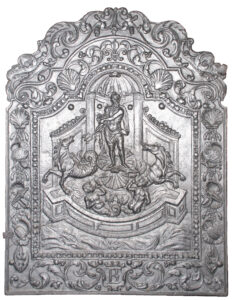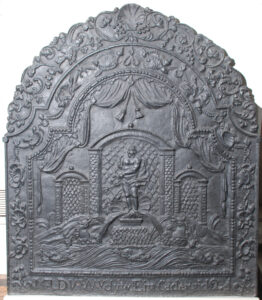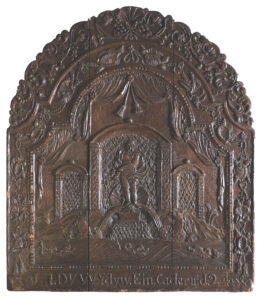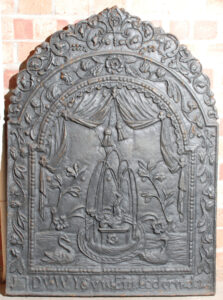
Daniel Marot (1661-1752) was born in France into a Protestant family of artists and designers. His grandfather was a cabinetmaker, and his father an architect to the king, Louis XIV. As a young man Marot worked with his father and with other celebrated craftsmen, himself becoming a leading designer of gardens, clocks, porcelain and decorative interiors. In 1685 the world with which he was familiar was shaken when French Protestant worship, tolerated since 1598 when Henri IV had signed the Edict of Nantes, was prohibited. To continue to work in his native land he had to conform to Roman Catholicism; the alternative was to leave. Together with a great many other Huguenots, as they were known, he chose to leave and emigrated to the Dutch Republic. There he became known to the Stadtholder, the head of state, William, Prince of Orange, who engaged Marot to design the interiors of the new royal residence, Het Loo.
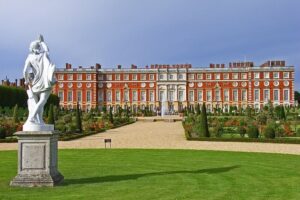
In 1688, the ‘Glorious Revolution’ led to James II of England fleeing and being succeeded jointly by his daughter Mary and the Dutch stadtholder William. In 1694 Daniel Marot came to England at the behest of William and began work on the gardens and interiors at Hampton Court Palace, which William was enlarging. Marot’s hand can be seen in several areas of design within the palace and he remained in England until 1696, whereupon he returned to the Netherlands for the rest of his life, and where, in 1703, he published the first of a set of drawings of designs for exterior and interior decoration, furniture, gardens and statuary.
In the years after the death of Queen Mary in 1694 Marot completed his work at Hampton Court but King William had lost interest in the project and Marot will have been able to take on private commissions. However, following William’s death in 1702 Queen Anne had the work on the new State Apartments completed. It must have been during this period that one particular fireback, now in the Queen’s Drawing Room, was probably installed. Its pattern was made by a woodcarver whose initials were EB and he based its design on one of the drawings of statues in the series that Marot had published in the Netherlands. It features a statue of the sea god Neptune standing on three scallop shells, with two hippocampi, or mythical sea-horses, and a mermaid and merman cavorting in a circular pool at his feet. While some artistic licence has been employed in the positioning of the sea-horses and the merpeople, Neptune’s pose and the domed niche behind him show clearly the source of the design.
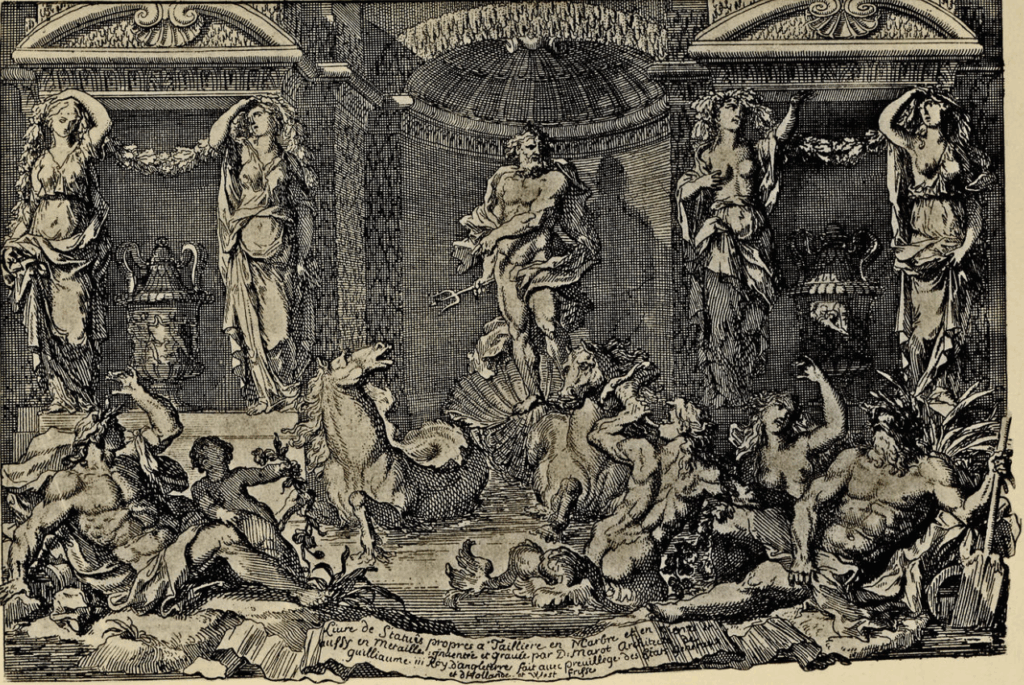
Another fireback designed by EB is in the adjacent Queen’s Audience Chamber, although this one drew its inspiration from a sixteenth-century illustration from Ovid’s Metamorphoses. A few other firebacks from his hand are also known.
Interior and exterior design inspired by paintings, drawings and prints had been influencing architects, plasterers and furniture makers since the sixteenth century so it is, perhaps, no surprise that one of Daniel Marot’s works should have been reproduced in iron in the building he had such a hand in decorating.
Twenty years passed before Marot’s drawings inspired two further firebacks. In 1724 a series of 13 firebacks were produced in a variety of sizes and designs. It must be assumed that they, or at least the larger ones, were commissioned by someone in Wales, for six of them bear the inscription ‘DVW Ydyw Ein Cadernid’ below the pictorial design along the bottom of the plate. Translated, this reads ‘God is our strength’ and is a paraphrase of verse 1 of Psalm 46. In all other respects the designs on these firebacks are secular in nature. The largest fireback in this series is another version of Marot’s Neptune statue drawing. While Neptune’s pose is consistent with, and indeed more faithful to, the original than EB’s interpretation, the hippocampi are less well developed and the merpeople are absent, being replaced by three fish.
Remarkably, the original wooden pattern for this fireback has survived. It is in the collection of the historical museum in Rotterdam having been acquired from an antique dealer in the Netherlands many years ago. Having recognised the hand of Daniel Marot, it was not unreasonable for the pattern to have been bought by the museum in his adopted country. However, labels on the back of the pattern indicate that it formerly came from London, for it and the others in the series of 1724 are undoubtedly British in origin.
A second fireback in the same series bearing the same Welsh inscription also has a design based on one of Marot’s drawings, this time of a fountain. It is also from the collection of drawings published in 1703 and comes from a page showing several fountain designs, the one chosen being the seated figure of a wyvern spouting water from its mouth. What the pattern-maker, whose identity is not revealed, has done is exactly what Marot probably intended, namely to isolate one of the many fountains displayed and reproduce it in an appropriate setting. The swan and the duck shown swimming around the wyvern may have been copied from designs by Francis Barlow, who is the subject of another note.

In 1712 Marot had published a second collection of designs, which included his original drawings. A familiarity with his designs may indicate that the pattern-makers responsible for these last two firebacks were also Huguenot refugee woodcarvers, or their descendants, who had set up a workshop where they could produce distinctive fireback patterns as well as other items of decorative woodwork such as picture and mirror frames and furniture.
